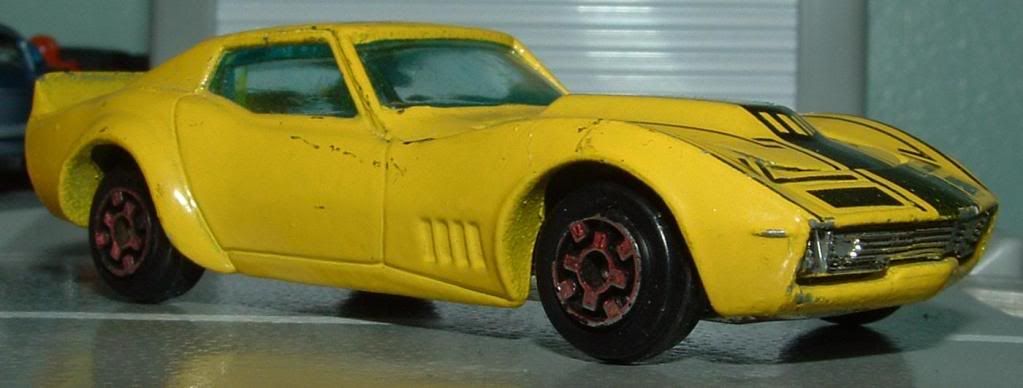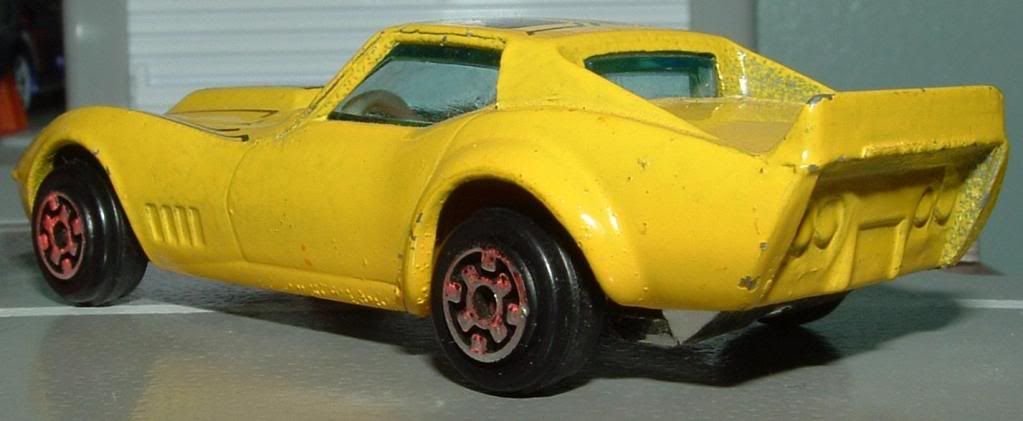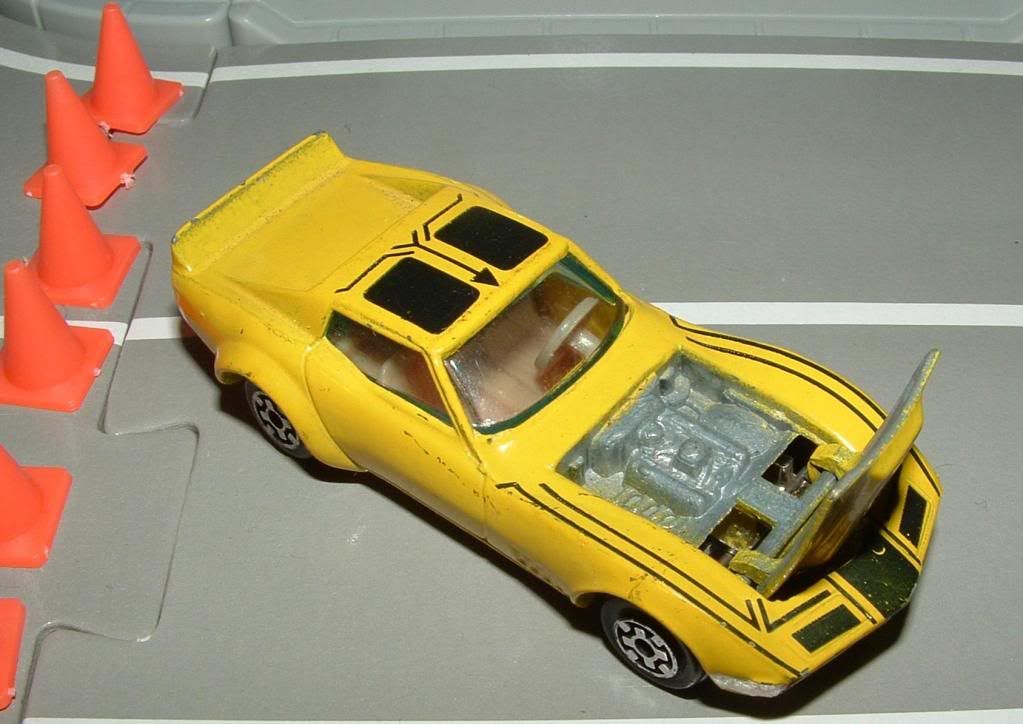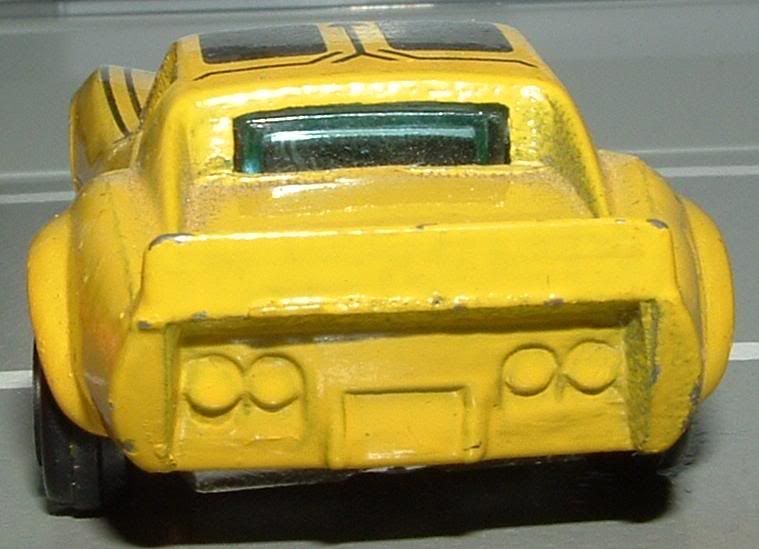
A blog focusing on 1/64 diecast from such popular brands as Hot Wheels, Matchbox, Johnny Lightning, M2 Machines, GreenLight, Tomica, Yat Ming, Majorette, MotorMax, Siku, Corgi, Guisval, Playart, Ertl, Zylmex, Racing Champions, & many more. Swifty's Garage features a daily Car Of The Day and news updates from your favorite brands!
Wednesday, November 9, 2011
Car Of The Day: November 9, 2011
Today's car of the day is Kidco's 1972 Chevrolet Corvette.
The Chevrolet Corvette (C3) is a sports car produced by the Chevrolet division of General Motors for the 1968 through 1982 model years. Corvette chief Zora Arkus-Duntov wanted a striking new Corvette; although engines and chassis components were mostly carried over from the previous generation, its body and interior were new. "Though initially flawed, the 1968 like the 1958, would improve and mature into a car precisely right for its time." The so-called Shark was produced during one of the most troubled periods in America: civil unrest, burgeoning federal guidelines, fuel economy and pollution regulations, oil embargoes, rising fuel and insurance costs, runaway inflation, and a lingering recession. Through it all the third generation Corvette continued to set new sales records with an all-time high of 53,807 produced for the 1979 model year.
For more information and pictures of the real car please visit: Chevrolet Corvette
Customizing Corvettes was a trend in the 1970s, and examples like this were not uncommon on the show circuit. Yat Ming's #1065 is also based on a modified C3 and the movie "Corvette Summer" pretty much sums up the whole trend.
For 1968, both the Corvette body and interior were completely redesigned. As before, the car was available in either coupe or convertible models, but coupes had new removable roof panels (T-tops) and a removable rear window. A soft folding top was included with convertibles, while an auxiliary hardtop with a glass rear window was offered at additional cost. Included with coupes were hold down straps and a pair of vinyl bags to store the roof panels, and above the luggage area was a rear window stowage tray. The enduring new body's concealed headlights moved into position via a vacuum operated system rather than electrically as on the previous generation, and the new hide-away windshield wipers utilized a problematic vacuum door. The door handles were flush with the top of the doors with a separate release button. "Sting Ray" nameplates were absent on the new 1968 body, but Chevrolet still advertised the car as a Sting Ray. Front fenders had functional engine cooling vents. Side vent windows were eliminated from all models, replaced with "Astro Ventilation", a fresh air circulation system. In the cabin, a large round speedometer and matching tachometer were positioned in front of the driver. Auxiliary gauges were clustered above the forward end of the console and included oil pressure, water temperature, ammeter, fuel gauge, and an analog clock. A fiber-optic system appeared on the console that monitored exterior lights and there was no glove box. The battery was relocated from the engine area to one of three compartments behind the seats to improve weight distribution. New options included a rear window defroster, anti-theft alarm system, bright metal wheel covers, and an AM-FM Stereo radio. All cars ordered with a radio, like the C2 cars, continued to be fitted with chrome-plated ignition shielding covering the distributor to reduce interference.
The chassis was carried over from the second generation models, retaining the fully independent suspension (with minor revisions) and the four-wheel disc brake system. The engine line-up and horsepower ratings were also carried over from the previous year as were the 3 and 4-speed manual transmissions. The new optional Turbo Hydramatic 3-speed automatic transmission (RPO M40) replaced the two-speed Powerglide. The L30, a 327 cu in (5.4 L) small-block V8 engine rated at 300 hp (224 kW) and a 3-speed manual transmission were standard, but only a few hundred 3-speed manual equipped cars were sold. The 4-speed manual was available in M20 wide-ratio or M21 close-ratio transmission versions. The M22 “Rock Crusher”, a heavy duty, close-ratio 4-speed gearbox, was also available for certain applications. The engine line-up included the L79, a 350 hp (261 kW) high performance version of the 327 cu in (5.4 L) small-block. Also available were several variants of the 427 cu in (7.0 L) big-block V8, that taken together made up nearly half the cars. There was the L36, a 390 hp (291 kW) version with a Rochester 4-barrel carburetor; The L68, a 400 hp (298 kW) motor with a Holley triple 2-barrel carb set up (3 X 2 tri-power); The L71, generating 435 hp (324 kW) with a tri-power; The L89 option was the L71 engine but with much lighter aluminum cylinder heads rather than the standard cast iron. Then there was the L88 engine that Chevrolet designed strictly for off-road use (racing), with a published rating of 430 hp (321 kW), but featured a high-capacity 4-barrel carb, aluminum heads, a unique air induction system, and an ultra-high compression ratio (12.5:1). All small block cars had low-profile hoods. All big block cars had domed hoods for additional engine clearance with twin simulated vents and “427” emblems on either side of the dome. The new seven-inch wide steel wheels had F70x15 nylon bias-ply tires standard with either white or red stripe tires optional. Rare options were: L88 engine (80), J56 heavy-duty brakes (81), UA6 alarm system (388), L89 aluminum heads (624).
In 1969, small block engine displacement increased from 327 cu in (5.4 L) to 350 cu in (5.7 L), though output remained the same. All other engines and transmission choices remained unchanged from the previous year, though the L30 base engine was now the ZQ3 and the L79 motor was redesignated the L46. All cars featured 8-inch-wide (200 mm) steel wheels (increased from 7 inches). Tire size remained the same, although this was the first year for optional white lettered tires and the last for red striped tires. Carried over from the previous year were seven available rear axle ratios ranging from 2.73 to 4.56. Standard ratio remained 3.08 with automatic and 3.36 with manual transmission. The optional Positraction rear axle, mandated on many engine/gearbox combinations, was installed on more than 95% of the cars. "Stingray" script nameplates appeared on front fenders, now one word, in contrast to the “Sting Ray” name used previously. Exterior door handles were redesigned so the finger plate would actuate the door, eliminating the separate release button. Backup lights were integrated into the inboard tail lights, headlight washers were added, and front grilles were made all black. Side mounted exhausts and front fender vent trim were options for this year only. On the inside, revised door panels provided additional shoulder room in the C3's tighter cabin and headrests became standard. Steering wheel diameter was reduced from 16 to 15 inches to permit easier entry and exit, the ignition switch was moved from the dash to the steering column, and map pockets were added to the dash area in front of the passenger seat. Accounting for 57% of the cars, coupes with their removable roof panels, began a trend of outselling roadsters. An extended production cycle due to a labor dispute increased '69 volume. This was the last year for the L88 engine and the only year for the ZL1 option, which offered an all aluminum 427 cu in (7.0 L) big-block engine listed at 430 hp (321 kW). Rare options: ZL1 aluminum block (2), J56 heavy-duty brakes (115), L88 engine (116), L89 aluminum heads (390).
Car and Driver magazine wrote in October 1968, “The small-engine Corvettes are marginally faster and extraordinarily civilized. The large-engine Corvettes are extraordinarily fast and marginally civilized.”
In 1970, fender flares were designed into the body contours to reduce wheel-thrown debris damage. New were egg-crate grills with matching front fender side vents and larger squared front directional lamps. The previously round dual exhaust outlets were made larger and rectangular in shape. Interiors were tweaked with redesigned seats and a new deluxe interior option combined wood-grain wood accents and higher-spec carpeting with leather seat surfaces. Positraction rear axle, tinted glass, and a wide-ratio 4-speed manual transmission were now standard. The 350 cu in (5.7 L) base engine (ZQ3) remained at 300 hp (224 kW) and the L46 was again offered as a 350 hp (261 kW) high performance upgrade. New was the LT-1, a 350 cu in (5.7 L) small-block V8 engine delivering a factory rated 370 hp (276 kW). It was a solid lifter motor featuring a forged steel crankshaft, 4-bolt main block, 11:1 compression ratio, impact extruded pistons, high-lift camshaft, low-restriction exhaust, aluminum intake manifold, 4-barrel carburetor, and finned aluminum rocker covers. The new engine, making up less than 8% of production, could not be ordered with air conditioning but was fitted with a domed hood adorned with “LT-1” decals.
Motor Trend in May 1970, clocked an LT-1 covering the quarter mile in 14.36 seconds at 101.69 mph and remarked, “There is Corvette and there is Porsche. One is the best engineering effort of America, the other of Germany. The difference in machines is not as great as the disparity in price.”
A special ZR1 package added racing suspension, brakes, stabilizer bars, and other high performance components to LT-1 cars. Big-block selection was down to one engine but displacement increased. The LS5 was a 454 cu in (7.4 L) motor generating 390 hp (291 kW) and accounted for a quarter of the cars. A second big-block, the 460 hp (343 kW) 454 cu in (7.4 L) LS7, was planned and appeared in Chevrolet literature but is not believed to have ever been delivered to retail customers. A short model year resulted in a disproportionately low production volume of 17,316, down nearly 60%. Rare options: ZR1 special engine package (25), shoulder belts in convertibles (475), LT-1 engine (1,287).
1971 cars were virtually identical in appearance to the previous model inside and out. This was the final year for the fiber optics light monitoring system, the headlight washer system, and the M22 heavy duty 4-speed manual gearbox. For the first time, air conditioning was installed on most of the cars, with nearly 53 percent so ordered. Engines were detuned with reduced compression ratios to tolerate lower octane fuel. The small blocks available were the 350 cu in (5.7 L) base engine, which dropped to 270 hp (201 kW), and the high performance LT-1, now listed at 330 hp (246 kW). The LS5 454 cu in (7.4 L) motor was carried over and produced 365 hp (272 kW). Offered in ‘71 only was the LS6 454 cu in (7.4 L) big-block featuring aluminum heads and delivering 425 hp (317 kW), highest of the 1970-72 series, and could be ordered with an automatic transmission. The ZR1 option was carried over for LT-1 equipped cars and the ZR2 option, offered this year only, provided a similar performance equipment package for LS6 cars, and restricted transmission to a 4-speed manual. Rare options: ZR1 special engine package (8), ZR2 special engine package (12), LS6 425-hp engine (188), shoulder belts in convertibles (677).
1972 was the last year for chrome bumpers at both front and rear, the vacuum actuated pop-up windshield wiper door, as well as the removable rear window common to all 1968-72 coupes. The key activated anti-theft alarm system became standard. The increasingly popular choice of an automatic transmission was installed in most corvettes for the first time, with nearly 54 percent so equipped. This year SAE net measurement for horsepower was now utilized (away from the previous SAE gross standard), and was largely responsible for the much lower engine output figures such as the 200 hp (149 kW) rating on the standard 350 cu in (5.7 L) motor. This was the final year for the LT-1 engine, rated at 255 hp (190 kW), and the ZR1 racing package built around it. Although the M22 HD 4-speed was no longer a Regular Production Option, it continued to be fitted to cars outfitted with the ZR1 package. The LT-1 could now be ordered with air conditioning, a combination not permitted the two previous years. The LS5 454 cu in (7.4 L) big block was again available and came in at 270 hp (201 kW). Noteworthy is in ’72 the LS5 was not available to California buyers. This was the beginning of a trend where Chevrolet restricted certain power train choices to Golden State buyers due to that state's practice of applying more stringent emission (smog) standards than mandated by federal regulations. Convertibles were a vanishing breed by ‘72, and the Stingray was no exception. It sold only 6,508 copies, amounting to 9% of the market, placing it number three; it was beaten by the number one-selling Cutlass Supreme, with 11,571, but beat the Impala's 6,456 and the Mustang's 6,401. Rare options: ZR1 special engine package (20), shoulder belts with convertibles (749), LT1 engine option (1,741).
1973 started Corvette's transformation from muscle to touring sports car. A Chevrolet advertisement headlined: "We gave it radials, a quieter ride, guard beams and a nose job." Indeed, redesigned body mounts and radial tires did improve Corvette's ride, and interior sound levels were reduced by 40%. The chrome rear bumper was essentially carried over from the previous year. However, the chrome blade front bumper was dropped for the federally required 5 mph (8.0 km/h) standard for a light-weight front bumper system with an inner transverse tube attached to the frame with two Omark-bolts-(special steel fasteners which absorbed energy when a forming die, pushed back by the bumper, was forced down their length), and an injection-molded urethane bumper cover. The urethane nose was chosen over Chevy's other alternative, a more protruding version of the previous metal bumper. The new urethane bumper assembly added thirty-five pounds to the front end. Two 350 cu in (5.7 L) small block engines were available. The base L-48 engine produced 190 hp (142 kW). The L-82 was introduced as the optional high performance small-block engine (replacing the LT-1 engine) and delivered 250 hp (186 kW). The new hydraulic lifter motor featured a forged steel crankshaft, running in a four-bolt main block, with special rods, impact extruded pistons, a higher lift camshaft, mated to special heads with larger valves running at a higher 9:1 compression, and included finned aluminum valve covers to help dissipate heat. The L-82 was designed to come on strong at higher RPM and ordered with nearly 20% of the cars at a cost of $299.
Car and Driver on the L-82 in December 1972, “…when it comes to making a choice, the L82 is the engine we prefer. Duntov and the other Corvette engineers gravitate toward the big blocks because they like the torque. And granted, the 454s will squirt through traffic with just a feather touch on the gas pedal. But, to us at least, the small block engine contributes to a fine sense of balance in the Corvette that is rare in any GT car, so rare that it would be a shame to exchange it for a few lb.-ft. of torque.”
The 454 cu in (7.4 L) LS-4 big-block V8 engine was offered delivering 275 hp (205 kW) and 15% of the cars were ordered so equipped. “454” emblems adorned the hood of big-block equipped Corvettes. All models featured a new cowl induction domed hood, which pulled air in through a rear hood intake into the engine compartment under full throttle, increasing power (but didn't show up in the horsepower ratings). 0-60 times were reduced by a second while keeping the engine compartment cooler. The new tire size was GR70-15 with white stripes or raised white letters optional. An aluminum wheel option was seen on 1973 and 1974 pilot cars, and a few 1973s were so equipped, but withheld for quality issues, and wouldn't be available until 1976.
Road & Track magazine stated in a 1973 road test: "For all its age, size and compromises, if the Corvette is equipped with the right options it is a pleasant and rewarding car to drive and this 1973 example was one the best Corvettes we've ever driven."
Subscribe to:
Post Comments (Atom)







No comments:
Post a Comment